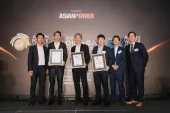
EY leader: Embrace the changing facets of the industry value chain
This advice comes as the complex and dynamic nature of the energy sector sees high demands on its talent pool.
Sanjeev Gupta is the EY Asia-Pacific Oil and Gas Leader and Strategy and Transactions Partner at Ernst & Young Solutions LLP, where he advises clients operating in the energy sector across the region, especially oil and gas, and the broader sector comprising metals and mining, power and utilities, renewables, and chemicals.
Gupta possesses an in-depth knowledge of the energy sector and has authored Asia Pacific Energy, Utilities and Mining Investment Guide in 2006, providing information on fiscal regimes and investment considerations across various markets within the region.
The EY partner has also rendered Strategy and Transactions as well as Assurance and Consulting services on several complex projects to super majors, national oil companies, large independents and other corporations operating in the energy industry.
Gupta has over 30 years of professional experience, wherein he has been to around 130 countries whilst serving clients and has been previously based in diverse markets including Indonesia, New Zealand, Australia, the United Arab Emirates, Saudi Arabia and India.
Gupta is a renowned figure in the industry and is active with the media in Asia and Europe where he has attended several live interviews at major networks as an industry specialist.
Observing the energy sector today, he mentioned that environmental, social and governance (ESG) considerations, energy transition, and liquefied natural gas (LNG) being a transitionary fuel as the three key trends impacting the sector amidst increasing demand for sustainability.
“We are seeing an increasingly active push from governments to curb emissions and reach carbon neutrality targets,” Gupta said.
Speaking with Asian Power, the EY leader shared how the latest trends in the energy sector are expected to affect the Asia Pacific region, as well as discussed some issues in the sector that can be associated with cross-border trade.
What latest trend do you observe in the energy sector today?
There are three key trends that are impacting the energy sector in a big way currently, and the overarching reason is the growing focus on sustainability. These key trends are ESG considerations, energy transition, and LNG as the transitionary fuel.
On ESG, we are seeing an increasingly active push from governments to curb emissions and reach carbon neutrality targets. These include initiatives such as the Sustainable Finance Disclosure Regulation (SFDR) by the European Union (EU) that requires financial institutions and investors to disclose Scope 1 and 2 emissions of their portfolio, with the inclusion of Scope 3 reporting from 2023. As a result, companies have started setting science-based targets on emissions and initiated pledges for net-zero objectives.
For the broader energy sector, examples of innovation driven by ESG considerations include the blending of electrification and biofuel to curb vehicle emissions; the aviation industry experimenting with blending of sustainable aviation fuel with jet fuel to reduce greenhouse gas emissions; and the shipping industry looking at clean ammonia and methanol as potential fuels to decarbonise marine transportation.
In terms of the energy transition, leading economies such as the US, China, the EU, Japan and India have taken significant steps to adopt low-carbon energy. According to the Renewables 2022 report by IEA, renewables will become the largest source of global electricity generation by early 2025. Their share of the power mix is forecast to increase by 10 percentage points over the forecast period, reaching 38% by 2027.
The hydrogen economy (especially blue and green hydrogen) is touted as the future of energy with carbon capture and storage (CCS) being the transitionary technology. Around 90% of hydrogen plants operational globally between 2022 and 2026 are for green hydrogen production, with a combined electrolyser capacity of nearly 86 GW. Additionally, wind and solar power projects will become increasingly the key areas of focus for oil and gas companies in their decarbonisation efforts.
Additionally, the advent of CCS has made liquefaction and transportation of natural gas a low-carbon alternative to power generation. Global LNG imports hit a record high of 409 million tons in 2022, up 5.8% from 2021 numbers. In 2022, the EU’s imports of LNG hit 101 million tons, a 58% surge compared to 2021. Europe continues to attract most of US exports of LNG.
Asia continues to attract significant demand in the near future as China continues to move away from coal. Globally, 75 planned, new-build LNG regasification plants are expected to start operations between 2023 and 2026, with a total capacity of over 11 trillion standard cubic feet (tcf) of gas. China is expected to contribute about 38% of this capacity.
Small-scale LNG continues to thrive in its niche segment to fulfil low-volume energy needs in different sectors, such as gas-based power plants or LNG bunkers in the shipping industry.
In the longer term, we expect investments in the electric vehicle ecosystem, integrated refineries and industrial internet will pave a greener path for the energy industry.
How will these trends impact the APAC region?
Renewables accounted for 42% of the Asian power market in 2022, with this share expected to increase to 63% by 2035.
Renewable capacity in Asia-Pacific is expected to grow by 360GW between 2023 and 2027. Solar photovoltaic (PV) accounts for over two-thirds of deployment, followed by wind and hydropower. Meanwhile, wind is expected to increase its share from 10% in 2022 to 18% by 2035. Coal-fired power generation is expected to reduce by over a third of the Asian power mix by 2035. The surge in the renewables sector throughout Asia-Pacific is expected to bring in more than US$300 billion in investments and generate close to 800,000 jobs.
China is forecast to install almost half of new global renewable power capacity between 2023 and 2027, as growth accelerates in the next five years despite the phasing out of wind and solar PV subsidies. The ambitious renewable energy targets in the 14th Five-Year Plan, market reforms and strong provincial government support will provide long-term revenue certainty for renewables.
What issues can be associated with cross-border trade and how are these addressed?
With the disruption of global supply chains and sanctions by western economies on Russian oil and gas, we are witnessing a major change in the cross-border energy trade flows. These global events have brought increased uncertainty on international energy demand-supply economics, which has led to price volatility, increased cost of financing and compliance, and change in the energy mix, amongst other challenges.
To win in these market conditions, companies need to focus on optimising supply chains and introducing robust policies and processes to reduce risks. Technology plays a central role in driving these objectives. Data-driven decision-making, digitalisation, industrial internet and automation especially for the upstream players, as well as real-time exposure management and geospatial monitoring are some of the technological advances that energy sector players need to consider.
How did your wide set of experience from diverse markets help you in your professional career?
Working with numerous energy companies across different geographies has helped me build a strong industry network, given me opportunities to experience various commodity cycles and expand my horizons to better understand and serve our clients. The discussions and exchange of ideas with industry stalwarts and the energy community broadens my perspectives and allows me to adapt to the ever-changing world of energy. My work has brought me to over 130 countries, whilst I’ve lived and worked in six different countries. The experience I have had from the work and the people I have met have helped me to grow further in my profession.
The energy sector is on a fast-track revolution towards finding alternative sustainable energy sources. Having worked on several complex projects with energy majors, national oil companies and other corporations across the value chain, I aim to leverage my knowledge and experience to help our clients in this commodity revolution. The innovations and advances in the energy sector will define a path for sustainable progress.
The intensely competitive nature of the industry demands that players continuously assess their standards and strive toward beating the market standards. Having led over 400 cross-border projects with some of the biggest commodity firms in the world, I look to leverage my experience to help clients achieve their goals, be it in business transactions or performance.
As an industry leader, what advice can you give to up-and-coming professionals who aspire to follow a similar career path as yours?
In the years ahead, we will see tremendous growth in employment generation in Southeast Asia’s energy sector. In particular, hydrogen, solar, wind and biofuels are expected to take centre stage. As oil and gas players seek to provide clean energy for consumers, they are also seizing growth opportunities that come with the energy transition. I would advise current and future leaders of the oil and gas sector to embrace the changing facets of the industry value chain and focus on new learnings to pursue growth.
The complex and dynamic nature of this industry has high demands on its talent pool. However, having worked in the sector for over 30 years, I can say that professionals looking to build their careers in the energy sector will find it an extremely fulfilling journey. Keeping up with changing market and geopolitical trends, demand-supply economics, sophisticated supply chains, and technological advances is necessary for anyone looking to thrive as an energy professional.
The industry is adopting sophisticated technology at a rapid pace currently. This opens a multitude of new prospects to up-and-coming professionals. Emerging technologies such as industrial internet, visualisation and robotics can revolutionise exploration and production whilst artificial intelligence and advanced analytics have redefined the risk management processes. Oil and gas professionals need to look into how to apply these new technologies to enhance the commodity value chain.
As a judge in the Asian Oil & Gas Awards, what do you think is the key component that sets the winning initiative apart from its competitors?
The winner should be able to demonstrate how they can be sustainable in the medium to long term and extend this impact to the industry and society.



















 Advertise
Advertise






